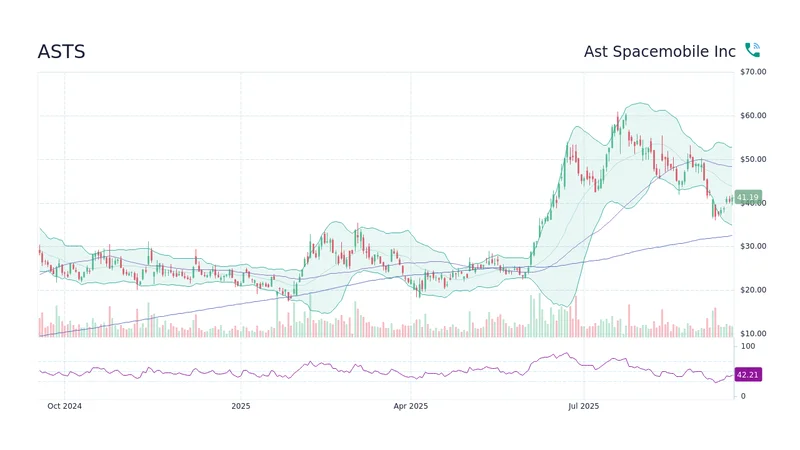The Blueprint for a Connected World Just Got Real
Alright, let's talk about AST SpaceMobile. When I pore over these Q3 2025 numbers, it’s not just about revenue or operating expenses – though we’ll get to those. What truly electrifies me, what makes my old MIT heart pound, is the sheer audacity of their vision and the undeniable, tangible progress they’re making. We’re not just talking about incremental improvements here; we’re witnessing the construction of a genuine paradigm shift, a global cellular broadband network in space that's designed to talk directly to your unmodified phone. Think about that for a second: no special equipment, no new devices, just your existing phone suddenly working everywhere. This isn't just a business update; it's a dispatch from the front lines of the future, and frankly, it's breathtaking.
The big idea here, the single most profound implication, is the absolute annihilation of connectivity gaps. Imagine five billion mobile subscribers, many in remote or underserved areas, suddenly having access to broadband. Or the billions more who currently have no connection at all. This isn't just about convenience; it's about empowerment, education, economic opportunity, and emergency services. It’s like the early days of the internet, or even better, the moment the printing press made knowledge accessible beyond the elite. This is connectivity for everyone, and when you look at AST SpaceMobile's latest moves, you can feel that future rushing towards us.
The Gears Are Turning, The Satellites Are Soaring
Let’s unpack the recent news, because it's a symphony of strategic moves and technical breakthroughs. They pulled in $14.7 million in Q3 revenue, driven by U.S. Government contracts – which, by the way, they just landed another one as a prime contractor. That’s not just income; that’s validation from the highest levels that this technology is real and vital. And yes, operating expenses jumped to $94.4 million, leading to a net loss of $122.874 million. But you know what? Building a global space network isn't cheap! This is the kind of massive upfront investment that defines a moonshot project, not a corner store. They’ve secured over $1.0 billion in contracted revenue commitments, including massive definitive commercial agreements with giants like Verizon and stc Group. The stc deal alone is a decade-long commitment covering Saudi Arabia and other MENA markets, even including a $175 million prepayment. That’s not just a handshake; that's serious money, a concrete vote of confidence from major players who understand the value of connecting their entire subscriber base.

And then there's the launch campaign, which has officially begun! BlueBird 6 is already en route to India for a December launch, with BlueBird 7 hot on its heels for Cape Canaveral. They're on track for five orbital launches by Q1 2026, aiming for 45 to 60 satellites by the end of 2026. This isn't some distant dream anymore; we're talking about satellites physically leaving Earth and taking their place in orbit, extending the reach of human communication. What happens when these first birds truly spread their wings and start providing consistent, widespread service? How will that initial taste of omnipresent connectivity change our expectations forever? When I first saw the progress on the BlueBird production line, seeing those immense structures coming together, I honestly just sat back in my chair, speechless. The sheer scale and ambition are just mind-boggling, and the speed of this is just staggering—it means the gap between today and tomorrow is closing faster than we can even comprehend, and we need to be ready for the societal shifts this will bring.
Funding the Future, Expanding the Horizon
What’s equally impressive is how they’re fueling this rocket. AST SpaceMobile closed a new 10-year convertible senior notes offering, raising $1.15 billion. That’s a massive injection of capital, showing significant investor confidence in their long-term vision. They’ve got $1.2 billion in cash and equivalents as of Q3, and pro forma, that number jumps to $3.2 billion when you factor in other available funds. This isn't just about getting by; it's about having the financial muscle to execute on a truly global scale. They've already poured approximately $1.2 billion into capitalized property and equipment – that’s the physical infrastructure, the factories, the satellites themselves.
The expansion plans are equally ambitious. Initial service activations are already providing nationwide intermittent service across the continental U.S. Can you imagine getting a text message from the middle of the desert, or making a call from a remote mountain trail, all without a single cell tower in sight? It’s a game-changer for emergency services, for adventurers, for anyone who's ever found themselves in a dead zone. And it's not stopping there. Vodafone is partnering for a new EU constellation, with Germany becoming the satellite operations center. Future activations are planned for Canada, Japan, Saudi Arabia, and the UK in early 2026. This isn’t a regional play; it’s a global blueprint unfolding before our eyes. We're talking about a proprietary ASIC, a specialized chip – in simpler terms, a super-powerful brain for their satellites – with 10 GHz of processing bandwidth, slated for integration in Q1 2026. This is the kind of deep technological innovation that ensures their lead in this nascent, but incredibly important, field. With such immense power comes immense responsibility, of course; we need to ensure this ubiquitous connectivity is used to uplift, not to divide, and that privacy and security remain paramount in this new digital frontier.
The Sky Isn't the Limit Anymore, It's the Network.
AST SpaceMobile isn't just building a company; they're building the infrastructure for a more connected, more equitable world. They're proving that the impossible is just a challenge waiting to be solved. These aren't just earnings reports; they're milestones on the path to a future where geographical isolation no longer means digital isolation. Get ready, because the world is about to get a whole lot smaller, and a whole lot more connected.
